

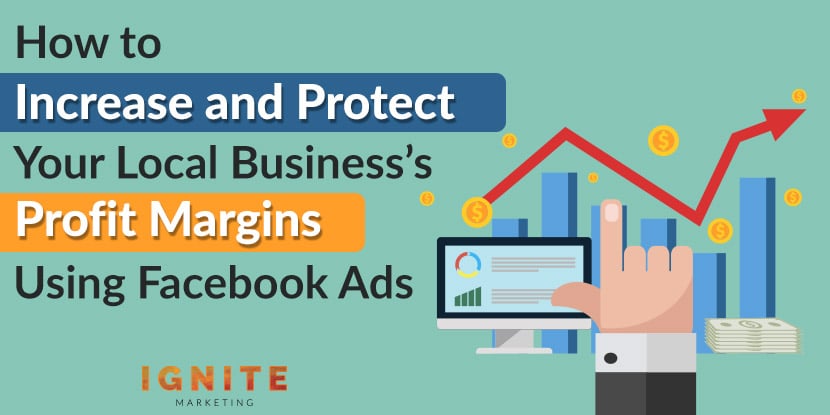
If you’ve been following my last few blog posts, we’ve been on a quite a journey you and I.
First, we navigated our way through one of the most powerful copywriting techniques you can use in Facebook Ads to increase click-through rates, signups, and inquiries. Next, we steered our way through creating campaigns designed to bump traffic, trials, and sales. In my last post, we tackled the difficult terrain of differentiating your business from competitors and then promoting that difference.
The core concepts shared in these posts were based on campaign categories outlined in Seducing Strangers by Joshua Weltman, but our journey isn’t finished just yet.
Weltman identifies a fourth and final category called mutual-love-and-respect ads (a.k.a. shared-value ads). While the other ads categories are designed to get customers through your doors, mutual-love-and-respect ads are designed to keep them there—or at least coming back for more.
In this post, I’ll break down this interesting ad category and explain how to create your own mutual-love-and-respect campaigns on Facebook. But let’s start with a fundamental two-part question…
If you want to know what works in your business, what doesn’t, and what you need to change, you’ll rarely find the answers within your own walls. Instead, the truth about your business lies with your customers.
You see, every decision a customer makes it based on a complex set of emotions. It’s the stuff that resonates with them. It’s what they experience. It’s what drives their loyalty. And believe it or not, your customers are unique to you. Their distinctive tastes, backgrounds, habits, behaviors, styles, and traits are what mutual-love-and-respect ads are all about.
Unlike differentiating ads that set your business, products, and services apart, mutual-love-and-respect ads differentiate your business based on your customers. They help consumers identify with you by conveying or demonstrating shared beliefs, values, or attitudes. They make people feel like they’re part of an exclusive club-like they belong. They make your target consumers feel like you get them.
When you analyze some of the most successful brands in the world, it quickly becomes clear there’s a common thread—something they understand: the power of developing a community around their brand. They understand how to cultivate a sense of shared identity, which is the foundation on which they build their following. As a result, they’re able to mobilize their customers in ways that many of their competitors can’t.
Consider Apple’s cult-like following. The tech giant not only understands the complex psychology of belonging, but their marketers understand the psyche of their fans. They’ve breeched emotional barriers and neurologically hooked their target customers, creating a deep sense of connection that motivates action. It’s why their unveilings are so well attended. It’s why thousands of people camp outside their stores and wait in lines several blocks long when a new product is about to be released.
How did they achieve this?
Partly by running mutual-love-and-respect campaigns like their “Think Different” ad.
To some people an iPhone is just an iPhone and an iPad is just an iPad. But for those who feel lost in the world, for those who don’t conform, and for those who want to feel special, Apple products are going to help them be innovators and creators. Apple products are going to help them reach their potential and make a difference in the world.
Why are mutual-love-and-respect ads so important?
The simple answer is that they appeal to your loyal audience members, effectively protecting your profit margins.
To break through the significant amount of promotional clutter your audience is subjected to in today’s world, you have to unearth your most passionate people and make sure you serve them well. Your local business is unlikely to survive if you don’t. Plus, it’s a lot more expensive to acquire a new customer than it is to retain one.
In Seducing Strangers, Weltman describes mutual-love-and-respect ads as “thank-you notes or inside jokes.” He further explains that the customers who matter most to a business’s profit margin don’t just buy into the products and services. They believe in the business’s “idea, philosophy, point of view, values, promise, and purpose.” The ads aren’t about selling or seducing. Instead, they’re about celebrating the differences in your customers.
Ultimately, consumers trust brands they feel understand them. They respect them, believing the brand respects them in return. The result is loyalty, and loyalty feeds profit and growth.
So, what do these ads look like?
To answer that question, let’s turn to two other brands that hit the nail on the head when it comes to mutual-love-and-respect ads.

Source: Best Copy Ads
REI believes that a life outdoors is a life well lived, and so do their customers. Their target audience would prefer to be surrounded by fresh air and nature than stuck behind a cubicle in a dreary air-conditioned building. Instead of enticing consumers with a sale or coupon in this ad, REI taps into powerful emotions and makes outdoor enthusiasts feel understood.
“For those who love to get outside and play” speaks to their target market in general, but the company cleverly takes it a step further by targeting individual audience segments. Notice in the ad above how they appeal to mountain bikers while the ad below targets fishing fanatics.
 Source: Best Copy Ads
Source: Best Copy Ads
In this Facebook ad, REI uses emotive language that appeals to campers.
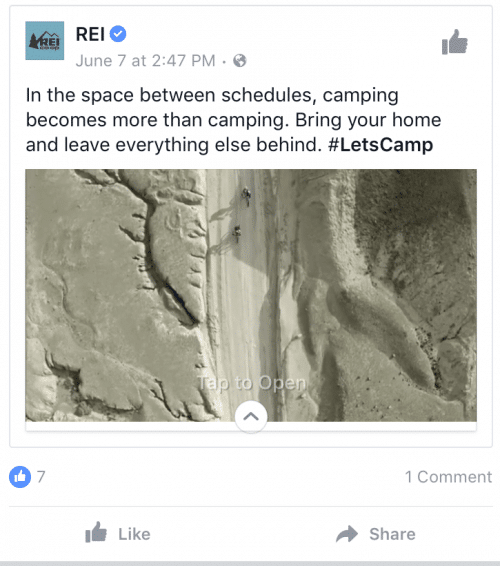 Source: WordStream
Source: WordStream
It’s clear that REI understands what motivates their most passionate consumers and uses that data to drive their mutual-love-and-respect campaigns.
Okay, okay. I know I’m going for another clothing and outdoor recreation retailer as an example, but it’s interesting to see how two similar companies with a very similar target audience tackles mutual-love-and-respect ads.
L.L.Bean knocks it out of the park with this seriously cool invisible ink newspaper ad you can only read outdoors.
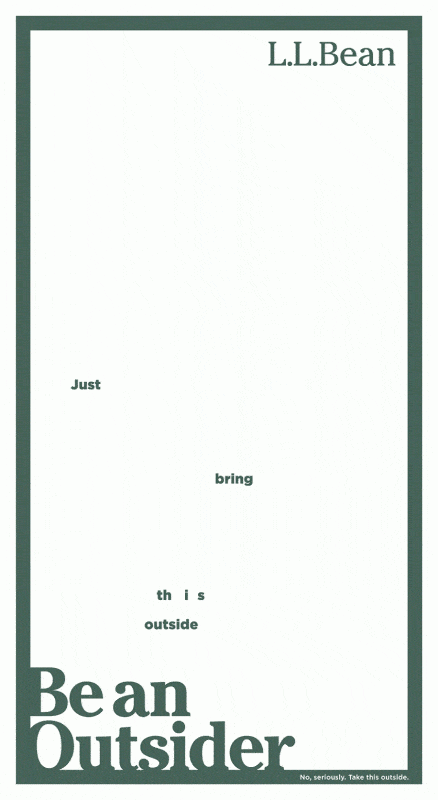 Source: Adweek
Source: Adweek
Forget about the photochromic ink and sophistication behind an ad like this for a moment and concentrate on how well L.L.Bean’s marketing team knows and understands their target audience. Pay attention to the copy and how deeply it resonates with people who love the outdoors.
When all is said and done, people are hardwired to search for support and understanding. For the outdoorsy type who buy from L.L.Bean, this kind of ad is going to cement the company as the brand that gets them on a deeper level than any other brand does.
With this in mind, how can you create campaigns that make your target consumers see that they can find both understanding and support in you?
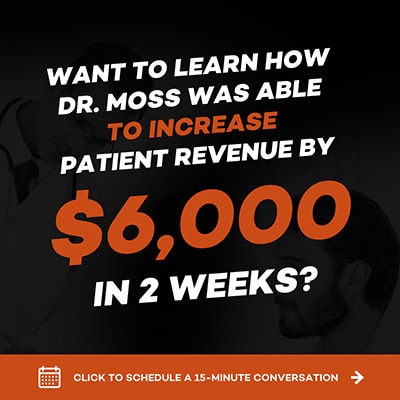 Step 1: Clearly Define Who You Are, What You Do Well, and Who You Serve
Step 1: Clearly Define Who You Are, What You Do Well, and Who You ServeIt sounds painfully obvious, but you’d be surprised how many business owners don’t relay this information quickly and clearly. However, who you are (including your values and beliefs), what your specialty is, and who you serve is crucial information that not only attracts the right customers but also helps them relate to you and your brand.
Any time a customer takes an action that shows their commitment, whether it’s a subscription or purchase, they’re buying into you. They’re actively joining you and aligning themselves with your business. Therefore, defining who you are, what you believe in and stand for, what you specialize in, and who you provide solutions for is the first critical step in creating a sense of belonging.
Let’s take a look at Nike’s philosophy and mission statement for a minute.
Mission: to bring inspiration and innovation to every athlete* in the world.
*If you have a body, you are an athlete.
Nike further explains:
“Our mission is what drives us to do everything possible to expand human potential. We do that by creating groundbreaking sport innovations, by making our products more sustainably, by building a creative and diverse global team and by making a positive impact in communities where we live and work.”
Nike believes in the power of sports to move the world. They believe that sport unites us. They believe in creating a more sustainable future by reducing their environmental impact. They believe in taking big risks to make big leaps.
Are those beliefs and values you can get behind?
What are the beliefs and values that drive your local business?
Not sure?
Start brainstorming what you want to communicate to your audience about yourself by answering some of these questions:
One you start to see your moral code develop, ask yourself whether these are values you can defend. Can you uphold them for a lifetime? Can your business uphold them? Will each value help you make decisions? Are these values congruent with your behavior? If you answered yes, you’re ready for step 2.
Be honest with yourself. How much time have you really spent trying to understand your customers?
As a local business owner, anything beyond basic customer research can seem like a luxury. You don’t have the resources, time, or team like big brands do.
Here’s the thing: customers need to feel they belong. When they feel truly recognized and appreciated, they’re loyal. You can have as much demographic data as you like, but statistical characteristics are only going to get you so far. You need to know what makes your ideal customers tick and what makes them feel like they belong.
Start by answering these questions:
Study these two Facebook Ads by Tough Mudder.

This type of minute detail can help you establish what sets your customers apart from everyone else’s. It can also help you figure out how to create the best experience ever.
Words have the power to make people feel connected and your copy can empower your audience to become part of something your competitors can’t offer. Loyal customers often turn into advocates, which is highly valuable to a small local business where word-of-mouth rules the revenue.
In some instances, communities even develop their own language to demonstrate their support. Consider celebs and their followings, for example. From Little Monsters, Lovatics, and Swifties to Directioners, Beliebers, and Arianators, their fans have created words to establish a bond.
If you don’t know any of these fan bases or which celeb they belong to, don’t worry—it’s their inside thing (exactly how Weltman describes mutual-love-and-respect ads). The language you use or the way you express yourself won’t appeal to everything and won’t be understood by everyone. And that’s okay. Remember, you’re looking for your most passionate audience.
With that in mind, what kind of strong, relatable words convey your shared values?
If you’re a chiropractor, you might focus on words around healthy families, alternative healing, and natural medicine. If you’re a real estate agent, you might focus on words that depict the fulfillment of a dream, or the types of home buyers you serve.
While not strictly mutual-love-and-respect ads, look at these campaigns by Harley Davidson.
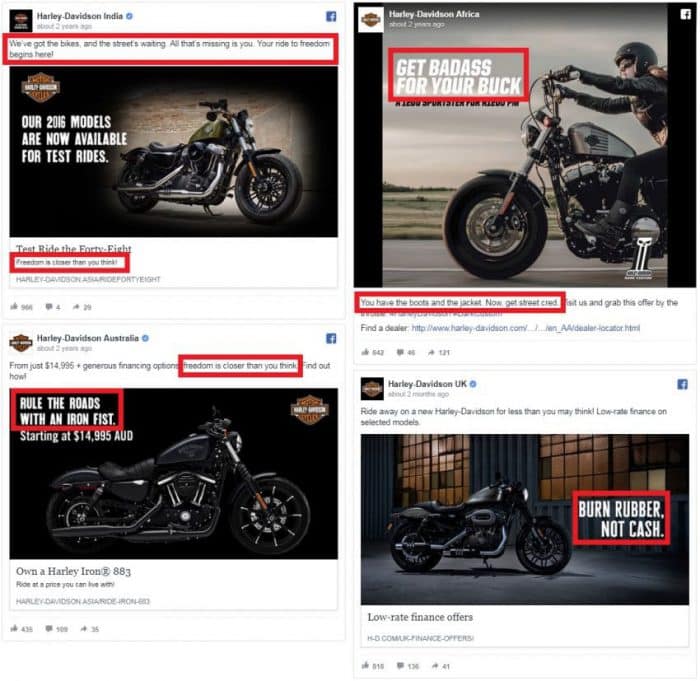 Their language is all about freedom and being a rebel. They ignite a sense of “Yeah, they get me.”
Their language is all about freedom and being a rebel. They ignite a sense of “Yeah, they get me.”
In Ketel One’s mutual-love-and-respect campaign, the company kept it simple:
 There were multiple ads in this campaign, all starting with “Dear Ketel One Drinker.”
There were multiple ads in this campaign, all starting with “Dear Ketel One Drinker.”
When you’re writing your own ad copy, make sure you frame your offer like it’s an invitation to an exclusive community. Tell a story about how clever and great your customers are for choosing you like this Dollar Shave Club ad.
 Who wouldn’t want to belong to an exclusive club of members who are praised for their “genius” because they’re getting a better shave for less?
Who wouldn’t want to belong to an exclusive club of members who are praised for their “genius” because they’re getting a better shave for less?
Compare the REI and L.L.Bean ad images above. While REI delivers rich, emotive visuals that make people long for their favorite pastime, L.L. Bean doesn’t use a visual at all.
So, which one is better?
The answer is that they’re equally effective in getting the message across. The novelty of invisible ink in an ad that only reacts to sunlight is enough to excite and delight readers.
As with any campaign, your visual should always support your ad copy. When you evaluate the language used in the Harley Davidson ads, you’re not expecting sweet images or light colors. You’re expecting grungy and dark visuals that speak to the raw, primitive emotions of their typical consumer.
Armed with your ad copy and image(s), you’ll want to set up your ad in Facebook and then set up the rest of your funnel using tools like ClickFunnels and an email marketing service like Aweber or MailChimp.
If you’re unsure how to use Facebook Ads Manager or you don’t know how to set up your funnel, grab a free copy of my step-by-step guide that walks you through the entire process of creating paid Facebook offers. Simply click the image below.
Not surprisingly, all four ad categories in Weltman’s book follow a natural progression.
Introductory ads: create curiosity about your products and services. They’re powered by an emotional appeal.
Trial ads: use discounts and limited-time offers to get people to try your offerings. These ads are fact based.
Differentiating ads: explain to people what’s better about your products or services compared to those of your competitors. Depending on the type of ad, these ads can be both fact-based and driven by emotion.
Mutual-love-and-respect ads: make your customers feel like they belong, which keeps them loyal and coming back for more. Like, introductory ads, they’re also powered by an emotional appeal.
When advertising, you shouldn’t pick just one. You should view each ad in the progression as an element of an overall persuasion campaign. You don’t want one-time benefits. You want to create promotions that have a long-lasting impact on your business and the products and services you offer.
How are you making your customers feel like they belong? Seen any mutual-love-and-respect ads we should study? Share your stories with us in the comment section below.
